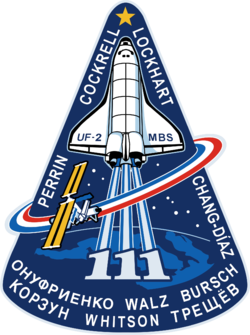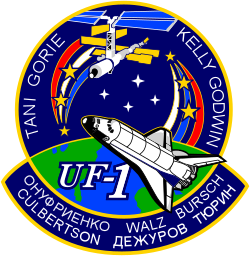Carl Walz
| Carl Erwin Walz | |
|---|---|
 | |
| Astronaut NASA | |
| Státní příslušnost | USA |
| Datum narození | 6. září 1955 (67 let) |
| Místo narození | |
| Předchozí zaměstnání | Inženýr a pilot Letectva USA |
| Hodnost | Plukovník letectva |
| Čas ve vesmíru | 230 dní, 13 hodin a 7 minut |
| Kosmonaut od | 17. ledna 1990 |
| Mise | STS-51, STS-65, STS-79/Mir, Expedice 4 (STS-108/ISS/STS-111) |
| Znaky misí | |
| Kosmonaut do | 8. prosince 2008 |
| Některá data mohou pocházet z datové položky. | |
Carl Erwin Walz (* 6. září 1955 v Clevelandu, Ohiu, USA), původně inženýr a pilot letectva Spojených států, byl od ledna 1990 do prosince 2008 astronautem NASA. Má za sebou čtyři kosmické lety, včetně šestiměsíčního pobytu na Mezinárodní vesmírné stanici (ISS). Celkem strávil ve vesmíru 230 dní, 13 hodin a 7 minut.
Život
Mládí
Carl Walz se narodil se v Clevelandu v Ohiu. Po ukončení střední školy v blízkém Lyndhurstu roku 1973 studoval fyziku na Kentské státní univerzitě (Kent State University) v Ohiu, roku 1977 zde získal titul bakaláře. Pokračoval ve studiu fyziky na Univerzitě Johna Carolla (John Carroll University) a roku 1979 se stal magistrem.[1] Od roku 1979 sloužil v letectvu v jednotce protiradiační ochrany. V letech 1983–1984 absolvoval pilotní školu (USAF Test Pilot School). Potom se na Edwardsově základně účastnil zkoušek vybavení letadel F-16C.[1]
Astronaut
Neúspěšně se zúčastnil se 12. náboru astronautů NASA. V následujícím, 13. náboru už prošel a 17. ledna 1990 byl začleněn do oddílu astronautů NASA. Absolvoval kurz všeobecné kosmické přípravy a v červenci 1991 získal kvalifikaci letového specialisty raketoplánu Space Shuttle.[2]
Po dokončení přípravy zastával různé funkce v NASA. Už po dvou letech odstartoval do vesmíru na palubě raketoplánu Discovery. Mise STS-51 začala 12. září 1993, po splnění programu letu astronauté přistáli v noci 22. září 1993 na Floridě, let trval 9 dní, 20 hodin a 12 minut.[3]
Ve dnech 8. – 23. července 1994 pobýval ve vesmíru podruhé. Let STS-65 raketoplánu Columbia trval 14 dní, 17 hodin a 56 minut. Programem mise bylo provedení experimentů v laboratoři Spacelab.[4]
Potřetí se do vesmíru dostal ve dnech 16. až 26. září 1996 v Shuttlu Atlantis při letu STS-79. Raketoplán navštívil ruskou stanici Mir na kterou dovezl zásoby a nového člena posádky. Délka letu byla 15 dní, 21 hodin a 21 minut.[5]
V listopadu 1997 byl jmenován palubním inženýrem záložní posádky Expedice 2 na Mezinárodní vesmírnou stanici (ISS) a hlavní posádky Expedice 4, kolegy v posádce se stali Jurij Onufrijenko a Daniel Bursch.[2]
Do vesmíru nová posádka ISS vzlétla 5. prosince 2001 v raketoplánu Endeavour (let STS-108). Po běžném půlročním pobytu na ISS se trojice Onufrijenko, Walz, Bursch vrátila na Zem opět v Endeavouru při letu STS-111. Přistání na Edwardsově základně v Kalifornii proběhlo 19. června 2002 po 195 dnech, 19 hodinách a 39 minutách letu.[6]
V prosinci 2008 odešel z NASA do soukromého sektoru.[2]
Carl Walz je ženatý, má dvě děti.[2]
Reference
- ↑ a b Biographical data. Carl E. Walz [online]. Houston: NASA, rev. 2008-12 [cit. 2009-10-19]. Dostupné v archivu pořízeném dne 2009-10-28. (anglicky) – Oficiální biografie NASA
- ↑ a b c d IVANOV, Ivan, a kol. Космическая энциклопедия ASTROnote [online]. Moskva: rev. 2008-12-15 [cit. 2009-10-19]. Kapitola Carl Erwin Walz. Dostupné online. (rusky)
- ↑ HOLUB, Aleš. MEK. Malá encyklopedie kosmonautiky [online]. Rev. 1997-08-13 [cit. 2009-10-19]. Kapitola STS-51 Di/F-17. [dále jen Holub]. Dostupné online.
- ↑ Holub. Rev. 1997-08-17 [cit. 2009-10-19]. Kapitola STS-65 Co/F-17.
- ↑ Holub. Rev. 1998-02-11 [cit. 2009-10-19]. Kapitola STS-79 At/F-17.
- ↑ Holub. Rev. 2002-06-20 [cit. 2009-10-13]. Kapitola Expedice 4.
Externí odkazy
 Obrázky, zvuky či videa k tématu Carl Walz na Wikimedia Commons
Obrázky, zvuky či videa k tématu Carl Walz na Wikimedia Commons
Média použitá na této stránce
STS-79 was the fourth in a series of NASA docking missions to the Russian Mir Space Station, leading up to the construction and operation of the International Space Station (ISS). As the first flight of the Spacehab Double Module, STS-79 encompassed research, test and evaluation of ISS, as well as logistics resupply for the Mir Space Station. STS-79 was also the first NASA-Mir American crew member exchange mission, with John E. Blaha (NASA-Mir-3) replacing Shannon W. Lucid (NASA-Mir-2) aboard the Mir Space Station. The lettering of their names either up or down denotes transport up to the Mir Space Station or return to Earth on STS-79. The patch is in the shape of the Space Shuttle's airlock hatch, symbolizing the gateway to international cooperation in space. The patch illustrates the historic cooperation between the United States and Russia in space. With the flags of Russia and the United States as a backdrop, the handshake of Extravehicular Mobility Unit (EMU) which are suited crew members symbolizes mission teamwork, not only of the crew members but also the teamwork between both countries space personnel in science, engineering, medicine and logistics.
STS111-S-001 --- The STS-111 patch symbolizes the hardware, people, and partner nations that contribute to the flight. The Space Shuttle rises on the plume of the Astronaut Office symbol, carrying the Canadian Mobile Base System (MBS) for installation while docked to the International Space Station (ISS). The mission is named UF-2 for ISS Utilization Flight number two. The ISS orbit completes the Astronaut Office symbol and is colored red, white, and blue to represent the flags of the United States, Russia, France, and Costa Rica. The Earth background shows Italy, which contributes the Multi Purpose Logistics Module (MPLM) used on this flight to re-supply ISS. The ten stars in the sky represent the ten astronauts and cosmonauts on orbit during the flight, and the star at the top of the patch represents the Johnson Space Center, in the state of Texas, from which the flight is managed. The names of the STS-111 crew border the upper part of the patch, and the Expedition Five (going up) and Expedition Four (coming down) crews’ names form the bottom of the patch. The NASA insignia design for Shuttle flights is reserved for use by the astronauts and for other official use as the NASA Administrator may authorize. Public availability has been approved only in the forms of illustrations by the various news media. When and if there is any change in this policy, which is not anticipated, the change will be publicly announced.
This is the mission patch of STS-108. Space Shuttle Endeavour is seen approaching the International Space Station. Two astronaut symbols represent the crew commanders of both ISS expeditions. The ascending one represents cosmonaut Yury Onufriyenko of Russia. (The ascending astronaut symbol shows a flag of Russia.) The descending astronaut symbol represents Frank Culbertson of the USA. This represents crew rotation, as three stars are depicted on the symbols. The space shuttle crew members are depicted along the border while the ISS crews are depicted along the chevron on the border of the patch.
- This is the insignia for the STS-108 mission, which marks a major milestone in the assembly of the International Space Station (ISS) as the first designated Utilization Flight, UF-1. The crew of Endeavour will bring the Expedition Four crew to ISS and return the Expedition Three crew to Earth. Endeavour will also launch with a Multi-Purpose Logistics Module (MPLM) that will be berthed to ISS and unloaded. The MPLM will be returned to Endeavour for the trip home and used again on a later flight. The crew patch depicts Endeavour and the ISS in the configuration at the time of arrival and docking. The Station is shown viewed along the direction of flight as will be seen by the Shuttle crew during their final approach and docking along the X-axis. The three ribbons and stars on the left side of the patch signify the returning Expedition Three crew. The red, white and blue order of the ribbons represents the American commander for that mission. The three ribbons and stars on the right depict the arriving Expedition Four crew. The white, blue, red order of the Expedition Four ribbon matches the color of the Russian flag and signifies that the commander of Expedition Four is a Russian cosmonaut. Each white star in the center of the patch represents the four Endeavour crew members. The names of the four astronauts who will crew Endeavour are shown along the top border of the patch. The three astronauts and three cosmonauts of the two expedition crews are shown on the chevron at the bottom of the patch.
Astronaut Carl Walz
STS-65 Mission Insignia
STS-51 Patch
The International Space Station (ISS) Expedition Four crew patch has an overall diamond shape, showing the "diamond in the rough" configuration of the Station during expedition four. The red hexagonal shape with stylized American and Russian flags represents the cross-sectional view of the S0 truss segment, which the crew will attach to the U.S. Lab Destiny. The persistent Sun shining on the Earth and Station represents the constant challenges that the crew and ground support team will face every day while operating the International Space Station, while shedding new light through daily research. The green portion of the Earth represents the fourth color in the visible spectrum and the black void of space represents humankind's constant quest to explore the unknown.







